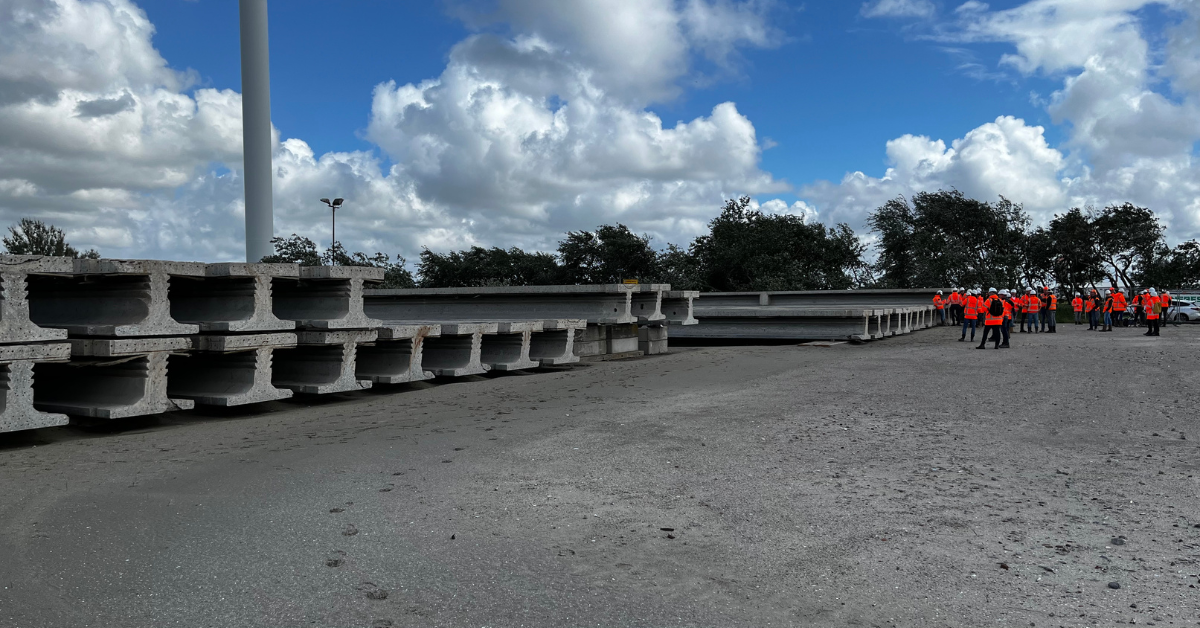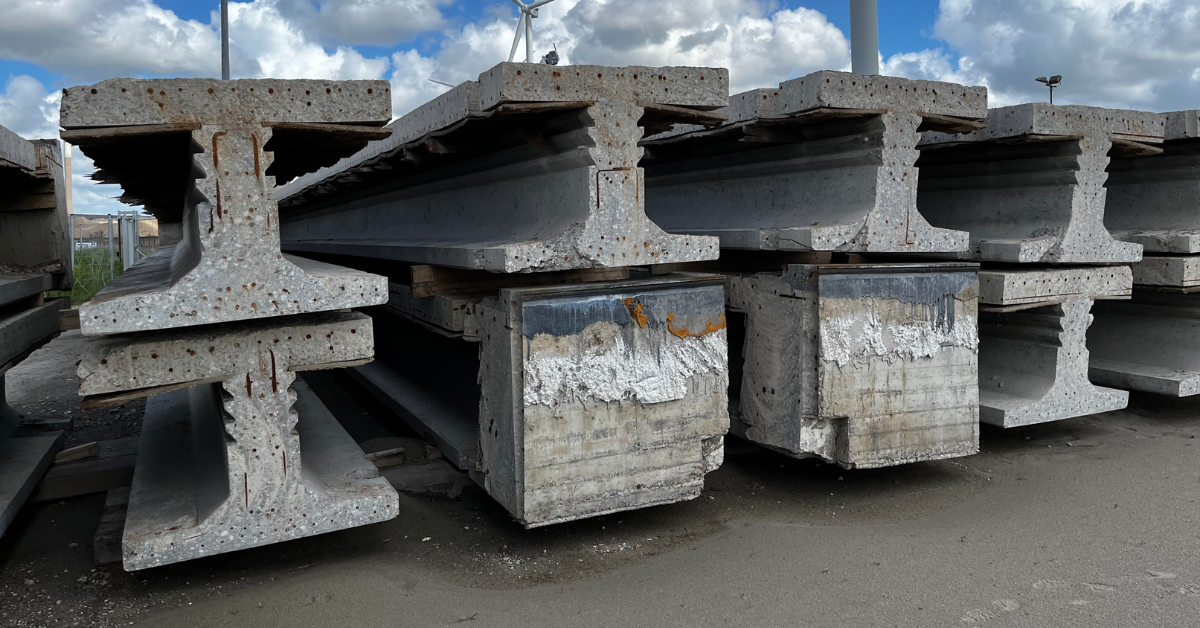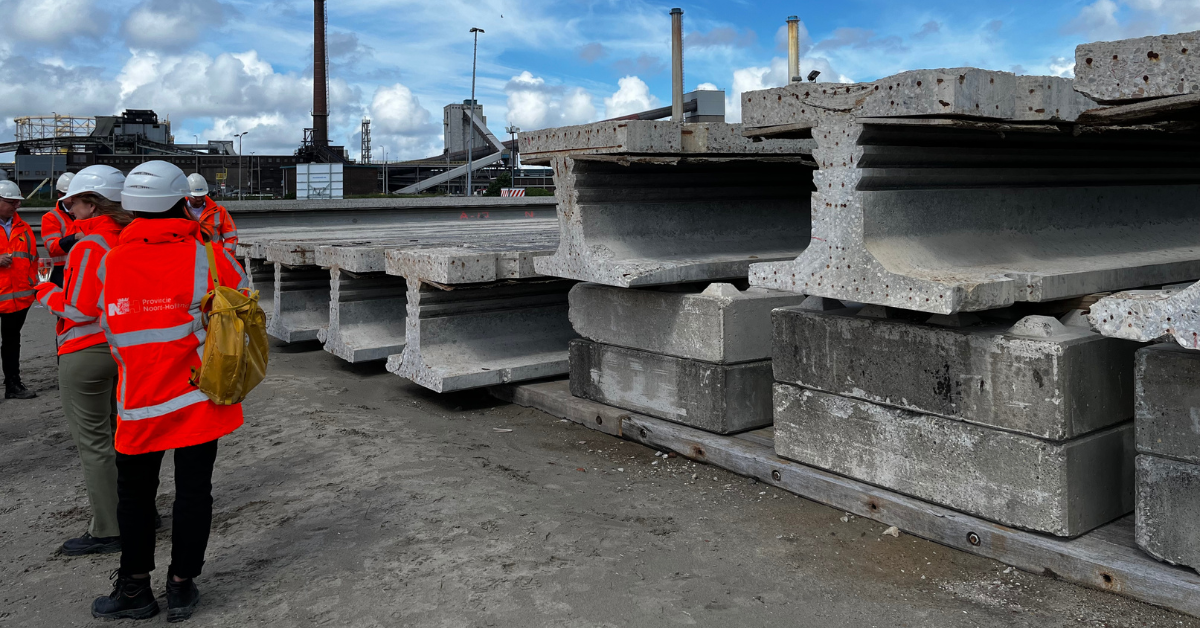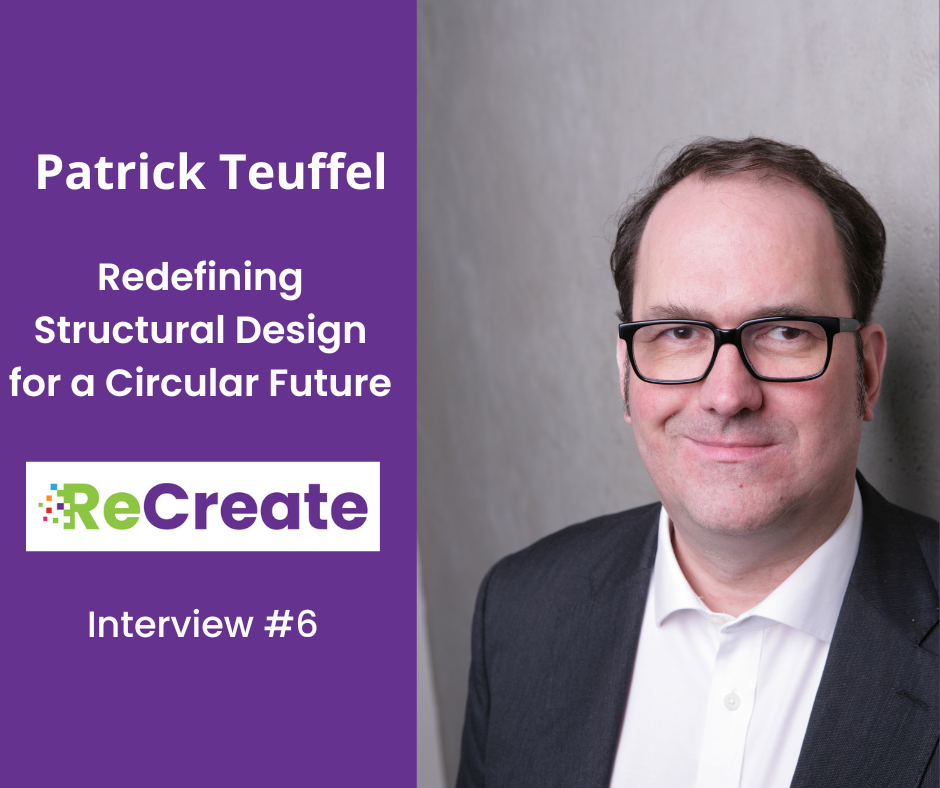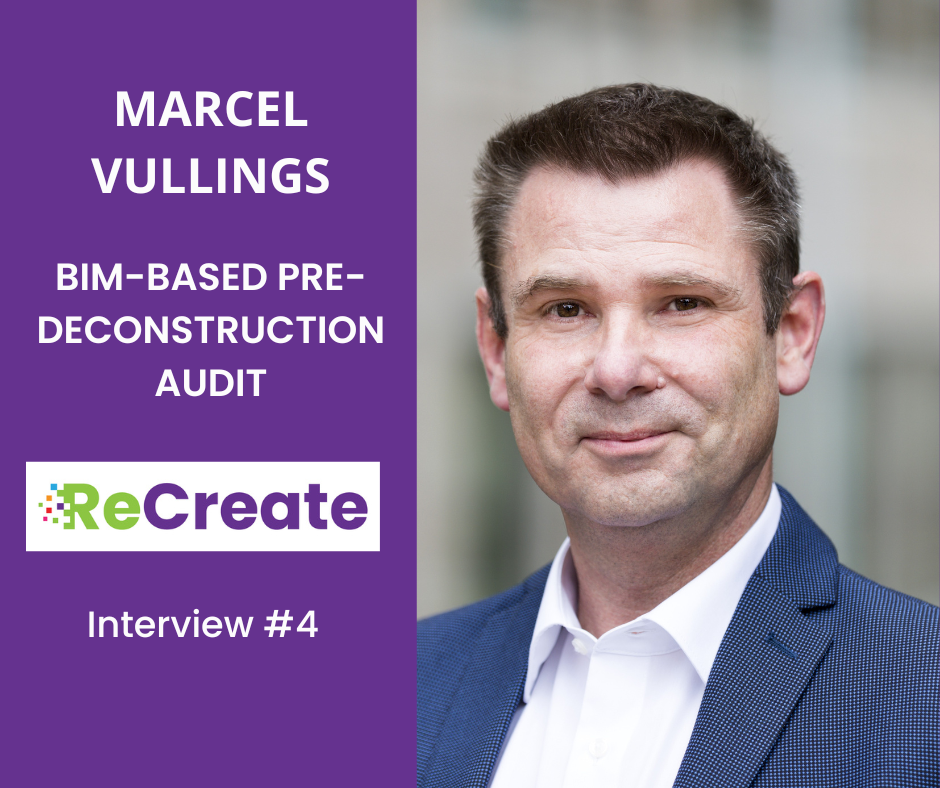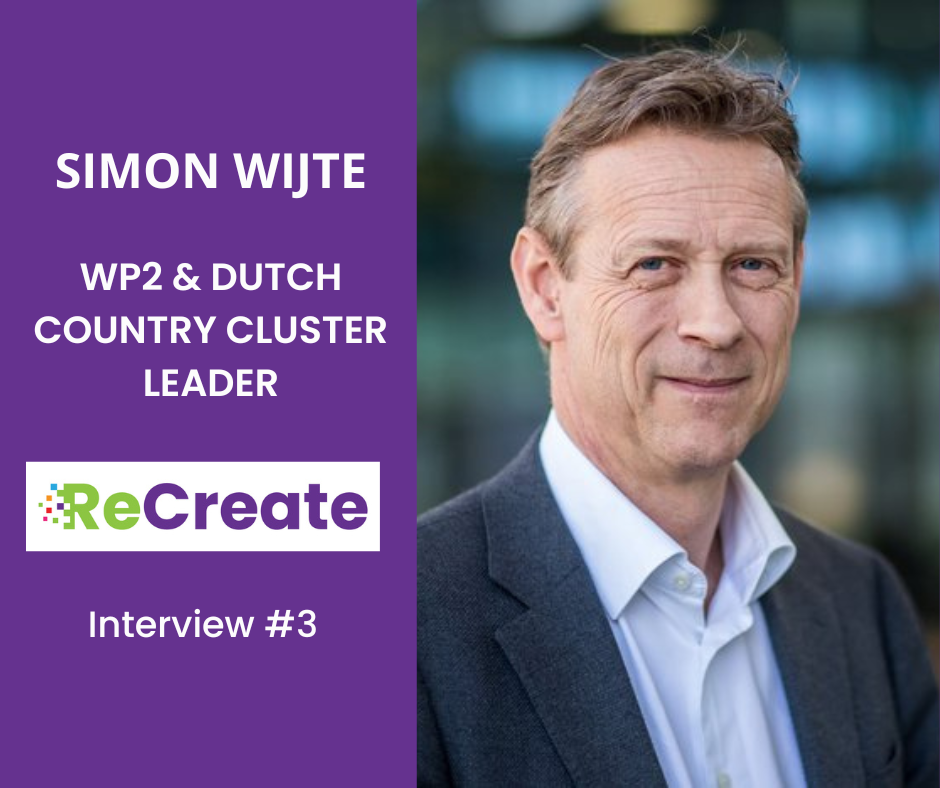As part of the activities under Work Package 2 of the ReCreate project, our project partners developed a BIM-based pre-deconstruction audit. We sat down with Marcel Vullings from TNO to gain more insight into the audit and to get more details. Here’s our full interview with him:
I: What is the main focus of the pre-deconstruction audit in the ReCreate project?
M: The main focus of the pre-deconstruction audit in the ReCreate project is to gather and validate the information that is crucial for the deconstruction process. This involves putting significant effort into tasks such as inspecting archives, conducting inspections and testing, and ensuring the traceability of information. The goal is to establish a comprehensive understanding of the structure and elements involved, making connections between the gathered information and the actual components. By undertaking these steps, the pre-deconstruction audit aims to provide a solid foundation for the subsequent deconstruction activities.
I: What type of data is gathered during the survey of the existing building in ReCreate?
M: The pre-deconstruction audit process begins with gathering information from the archives to prepare for the building inspection. Once the necessary preparations are made, the next step is to inspect the building itself. Before conducting the inspection, it is important to strip the building of loose items such as carpets and wallpaper to ensure clear visibility of the structural elements. This provides an opportunity to thoroughly examine the structure.
During the inspection, several factors are considered. The overall state of the structure and its elements is assessed, looking for any signs of damage, cracking, or corrosion. Deviations from the norm are noted, such as brown spots that may indicate possible corrosion. Detailed documentation is crucial, including taking pictures and measurements of cracks and other issues. Videos are recorded to allow for a review of the inspection back at the office. Both overall views and close-ups of specific details are captured.
To ensure accurate understanding, it is important to make sense of the gathered information and create a cohesive narrative. Measurements of various dimensions are taken, and a comparison is made between the building’s drawings and its actual construction. Changes may have been made over time or during the building process. Digitalizing the building, its structure, and its elements is also part of the process, utilizing different types of measuring devices.
Finally, both the interior and exterior of the building are inspected to ensure a comprehensive assessment.
I: How is the identification system in ReCreate utilized to trace and couple physical elements with data?
M: Tracking and tracing each separate element is of utmost importance throughout the entire process. This is essential because when designing a new structure, structural engineers need to provide calculations, reports, and drawings to demonstrate that the structure is safe and compliant with regulations. Various checks, including those by municipalities, are conducted to ensure that each part of the structure performs as specified in the documentation.
For reused elements, the information associated with each element is crucial. Any mix-up or uncertainty regarding the information of a particular element can have severe consequences. Therefore, if there is any doubt about the information of an element at any point in the process, it cannot be reused and becomes useless. The objective, however, is to reuse elements whenever possible.
To achieve effective tracking and tracing, it is essential to connect the information to the corresponding elements such as columns, beams, walls, slabs, etc. This can be accomplished by attaching tags to the elements during the initial phases of deconstruction or up until the moment an element is deconstructed. It is crucial not to delay this process. The location of an element in the old structure serves as the only clue to establish the connection between the physical element and the associated information.
Tags can take the form of marks, such as barcodes, QR codes, or plastic tags placed on the elements. Alternatively, electronic tags can be used. These marks and tags need to be secure and durable enough to withstand deconstruction, transportation, storage, handling, reconstruction, as well as exposure to various weather conditions, heat, and sunlight. They must be foolproof.
In addition to secure marking, establishing and maintaining a robust connection with a database or information system is essential. Building Information Modeling (BIM) models of the elements can also be utilized to ensure a continuous and reliable link between the physical elements and their corresponding information.
I: Why is it important to identify hazardous and/or toxic materials before dismantling a building in the ReCreate project?
M: Strict regulations are in place to address hazardous and toxic materials, aiming to establish and uphold a healthy work environment for workers, ensure the well-being of the surrounding area, and contribute to a healthy overall environment. It is crucial to adhere to these regulations to create a safe and sustainable space. Materials falling under this category cannot be reused and must be handled separately and disposed of in a safe and environmentally friendly manner.
To effectively manage these materials, it is essential to determine their presence within the building. For instance, in the case of asbestos, special suits are required for safe removal. The process of identifying and dealing with hazardous materials is subject to scrutiny by the department of health. Mistakes in handling these materials can have severe consequences, including loss of life or significant fines.
Compliance with the regulations ensures the protection of both workers and the environment, emphasizing the importance of following proper protocols for the safe removal and disposal of hazardous and toxic materials.
I: What methods are used to record visual or detectable damage to elements in the pre-deconstruction audit?
M: At various stages throughout the process, the structure and elements undergo inspections to assess any damages, degradation, or cracking. These inspections occur from the initial assessment until the element is reassembled in a new building. The goal is to determine whether an element can be reused and ensure its proper performance throughout its new lifespan, which could extend for several decades or even longer.
Inspections rely on a combination of visual examination by experts, along with the use of pictures, videos, and electronic measuring devices such as point cloud measurements. Additionally, simple tapping on the surface of the concrete can provide valuable information. Specialized equipment like the Schmidt hammer and ferro scanners may also be employed for more detailed analysis.
However, it is crucial that these inspections are carried out by specialists, as not every crack or damage is necessarily catastrophic. Concrete structures commonly exhibit cracks, which are even accounted for and described in the Eurocodes—design standards for concrete structures. The size and location of cracks play a significant role in assessing their impact and determining whether they conform to acceptable limits. Therefore, the expertise of specialists is vital in accurately interpreting the findings of these inspections.
I: How does the surveying process in ReCreate address stability issues during deconstruction?
M: Before carrying out the deconstruction itself, a structural engineer investigates the precast concrete structure to determine the optimal approach for dismantling the building, including the sequence of removing each element. This process must prioritize safety and ensure the stability of the remaining structure throughout the deconstruction process. To achieve this, a comprehensive deconstruction plan is created, which may involve implementing measures such as temporary scaffolding to stabilize the structure during the deconstruction phase.
I: What information does the survey aim to gather regarding the construction methods and structural systems of load-bearing elements?
M: This process can involve a considerable amount of technicality, but it can also be straightforward. Take, for instance, the location of a building, which provides valuable insights into its wind loading. Various factors differentiate a building situated at sea, inland, on an open plain, or within a city. Additionally, the dimensions of the building are crucial. Larger buildings must withstand greater and higher wind loads compared to smaller ones. However, for a structural engineer to accurately assess the load-bearing capacity of each precast concrete element, precise knowledge of the element’s location, layout, and dimensions is required. It is also essential to have information about the material properties of the steel and concrete, as well as how they are interconnected within the structure.
Furthermore, even the positioning of an element within the building, such as a column, provides relevant information. A ground-floor column typically exhibits greater load-bearing capacity than a column located at the top of a building. All of this information serves as valuable clues to determine the load-bearing capacity of each precast concrete element. The more comprehensive the available information, the more accurate the assessment becomes. In essence, if the dimensions of an element, a detailed description of the reinforcement, and the correct material properties are known, a structural engineer can reverse engineer the load-bearing capacity of that element. This process can be complex, but having additional information significantly simplifies it.
I: How does the acquired knowledge during the survey stage contribute to deconstruction planning in ReCreate?
M: Yes, this information is crucial for creating a deconstruction plan and ensuring the feasibility of the deconstruction process. Without it, the undertaking becomes unsafe and hazardous. A comprehensive deconstruction plan is essential, requiring detailed information about the building, structure, materials, connections, and the shape of the elements, among other factors. For instance, if the method of connection between elements is unknown, it becomes challenging to determine the appropriate cutting approach to separate the elements from the structure effectively. Consequently, incorrect cutting can lead to damage and render the elements unusable.
I: How does the pre-deconstruction audit combine modern survey technologies with traditional building surveying techniques?
M: During the audit, a wide range of methods are employed, with each task requiring its own specific technique. Various techniques and tools are utilized to simplify the process and gather accurate information quickly and reliably. These techniques and tools can be quite straightforward, such as visual observation, using a simple ruler for measurements, or employing a laser scanner to measure distances. Drones may also be employed to access challenging locations, such as high facades of buildings. Ferro scanners play a crucial role in detecting reinforcement within the concrete elements, while even a loupe can be utilized to measure the width of cracks in concrete. Additionally, pictures and videos are used to digitally measure elements. The available range of techniques and tools is extensive, offering a diverse array of options for conducting the audit.
I: What role does non-destructive electromagnetic and radar identification play in the ReCreate project, specifically during the survey of the donor building?
M: The non-destructive nature of obtaining information from precast concrete elements is evident, as the goal is to avoid damaging or destroying the elements in the process. Therefore, techniques employed to gather information must be non-destructive. In concrete, one critical aspect of obtaining information pertains to the location and dimensions of the reinforcement within the precast concrete element. These factors determine the element’s load-bearing capacity. Concrete elements require steel reinforcement, with concrete handling compression and steel managing tension—an ideal combination.
Steel can be detected using magnets, whether traditional or electronic magnets utilizing electromagnetics. A scanner is used to glide over the surface of the concrete, while the magnets detect variations and discrepancies. The scanner’s software interprets this information, providing readable details about the reinforcement within the concrete element. However, it is important to acknowledge the limitations of this technique. In certain situations, these methods may not be entirely reliable. To ensure accurate findings, it is essential to gather collaborating information from various sources, such as drawings, old calculations, and even resorting to destructive testing if necessary. Destructive testing involves breaking a portion of the element to visually examine it. Although this may result in sacrificing some elements, it becomes a last resort when other methods fail to provide satisfactory information.
I: How does ReCreate plan to bridge the gap from deconstruction to controlled disassembly for future buildings?
M: ReCreate plans to bridge the gap from deconstruction to controlled disassembly for future buildings through extensive data gathering and knowledge sharing. The project aims to learn from real-life pilot projects, examining what works, what doesn’t, and identifying areas for improvement. One important observation made during these pilots is that plastic tags are not suitable due to the fading of text under sunlight, rendering them unreadable. This highlights the need to explore alternative tagging methods.
Various methods of cutting through elements were explored, including sawing (using blades and cables), drilling, and high-pressure water jets. Each method has its pros and cons, and it is essential to understand and utilize them appropriately. There is no one-size-fits-all approach or tool for deconstruction. Efficiency and safety must be combined, taking into account the specific requirements of each project.
The ReCreate project, with its pilot projects conducted in different countries, aims to collect valuable data, information, and experiences. This wealth of knowledge is expected to have a significant impact, benefiting numerous projects in the future. TNO, as part of the project, plans to apply this new knowledge to other projects, including different types of deconstruction projects such as infrastructure, as well as exploring other materials like steel and wood structures. The research conducted within ReCreate has the potential for widespread application across various domains.
I: What role does cost-efficiency play in the development of the pre-deconstruction audit process in ReCreate?
M: Cost-efficiency plays a significant role in the development of the pre-deconstruction audit process in ReCreate. Currently, cost remains the primary factor driving the choice of methods for recycling concrete structures. Traditional demolition is often perceived as the cheapest option and, consequently, the most widely employed approach, despite its limited environmental friendliness. However, there is a need for a shift in societal mindset towards normalizing the reuse of materials and products as the first and natural step, rather than defaulting to purchasing new ones.
Lowering the costs associated with deconstruction and the reuse of precast concrete elements is a crucial objective. In this regard, ReCreate’s efforts are commendable, as the project strives to provide valuable services in enhancing efficiency within the field. Furthermore, implementing regulations and other measures can contribute to achieving cost efficiency and promoting sustainable practices in the industry. By addressing cost barriers and highlighting the economic benefits of deconstruction and material reuse, ReCreate aims to drive the adoption of more environmentally friendly practices in the construction sector.
I: How does ReCreate aim to optimize the detection methods in relation to the prefab systems and decoupling methods?
M: ReCreate aims to optimize the detection methods in relation to prefab systems and decoupling methods by considering them as additional tools rather than the sole approach. While detection plays a role, it is not the sole method employed. The study of original design drawings and calculations serves as the primary source of information for decoupling. Additionally, inspections and a comprehensive understanding of precast concrete structures provide a complete picture of the building. Detection techniques can be utilized to identify reinforcement in connections and other anchor systems where applicable. By integrating various approaches, ReCreate seeks to enhance the overall effectiveness of detection methods in relation to prefab systems and decoupling processes.
I: What is the significance of testing and validating the generic approach developed in ReCreate’s real-life pilot projects?
M: Testing and validating the generic approach developed in ReCreate’s real-life pilot projects holds great significance. It offers a comprehensive understanding of the entire deconstruction and reassembly process involving reused precast concrete elements. This includes all the associated aspects such as life cycle assessment (LCA), life cycle costing (LCC), compliance with regulations, development of business models, effective planning, information management, data gathering, innovative design approaches for structures using reused elements, creation of new connections, and the integration of old and new components through demountable connections.
The ability to observe these processes in real-life scenarios through four distinct pilot projects in different countries, involving diverse organizations and companies, provides invaluable insights. It allows for a thorough examination of the practical implementation of the generic approach, assessing its feasibility, effectiveness, and potential for scalability. These pilot projects serve as a robust testing ground, offering the opportunity to refine and validate the developed approach based on real-world challenges and outcomes. Ultimately, the knowledge gained from these pilot projects will contribute to advancing sustainable practices in the construction industry and facilitating the widespread adoption of the ReCreate project’s principles and methodologies.
